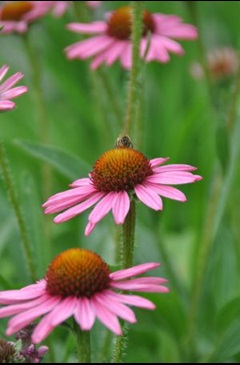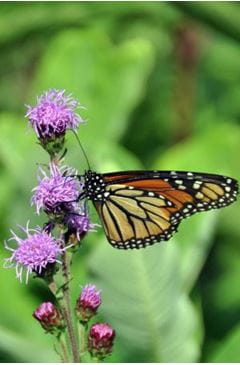
Landscaping
Español | Hmoob | Русский | Af Soomaali
Urban stormwater
Stormwater runoff in this area drains directly into the Mississippi River. Keeping storm water on our site helps reduce pollutants in the river and reduces flooding downstream.
The power of plantings
Vegetation plays a vital role in protection against wind and water erosion and the management of storm water runoff.

The plants on this slope were each chosen for their deep roots, ability to prevent erosion, and capacity for absorbing storm water runoff. Turf grass is the one on the left and native plants are the three on the right.
Jellyfish for stormwater?
The purple ramp also uses a special Jellyfish® Filter that removes pollutants before the water reaches the city’s storm drains.


Allina Health is proud to reduce storm water as part of our whole person care philosophy. Taking care of our environment is critical to ensure good health for Allina Health patients, employees and our community.
Español | Hmoob | Русский | Af Soomaali

Early Bloomer
Wild Geranium(Geranium maculatum)
(Creative Commons)

Mid-summer Bloomer
Butterfly Weed
(Asclepias tuberosa)
(credit: University of St. Thomas)

Late Bloomer
Wild Bergamot
(Monarda fistulosa)
(credit: University of St. Thomas)
Bees are one of the most well known pollinators, but there are a variety of other pollinators including butterflies, ants, flies, beetles, birds and more! By carrying pollen from one plant to another, pollinators fertilize plants and allow them to make fruit or seeds. Pollinator health is critical to our food system and the diversity of life across the world. The flowers on this slope were specially selected to provide food and habitat for pollinators throughout the growing season. How many kinds of pollinator plants are blooming right now? Allina Health is proud to reduce storm water and protect pollinators as part of our whole person care philosophy. Taking care of our environment is critical to ensure good health for Allina Health patients, employees and our community.

Midtown Greenway Bike Path
Español | Hmoob | Русский | Af Soomaali

Many pollinator species such as the rusty-patched bumble bee are declining in part due to habitat loss and degradation. Even after blooms fade, the plants still provide a landing spot for these special creatures.
The federally endangered Minnesota state bee, the rusty-patched bumble bee, is pictured to the left on Wild Bergamot at St. Thomas University.
 Left:
Left:
Purple Coneflower (Echinacea purpurea) attracts a diversity of pollinators including honeybees, common eastern bumblebees, sweat bees, long-horned bees and butterflies.
Pictured on the left is a honeybee.
Right:
Rough Blazingstar (Liatris aspera) is a particular favorite of butterflies.
Pictured on the right is the Minnesota state butterfly, the monarch.
Photo credits: University of St. Thomas

Golden Alexander (Zizia aurea) has bright blooms that attract all kinds of critters, including Common Eastern bumblebees, beetles, bee mimic flies (syrphid flies) and various tiny dark bees, such as genera Lasioglossum (small sweat bees), Ceratina (small carpenter bees) and Hylaeus (yellow-faced bees).
Pictured to the left is a bumblebee on a Golden Alexander.
Did you know?
Allina health offers secure bike storage?
Visit us on your bike!
Español | Hmoob | Русский | Af Soomaali
Our green initiatives
Electric vehicles reduce pollution from tailpipe emissions. This ramp includes charging space for 20 electric vehicles.
Allina Health is proud to reduce air pollution by promoting green spaces, solar energy and electric vehicles as part of our whole person care philosophy.

Plants and green spaces improve air quality by soaking up carbon from the atmosphere. The burning of fossil fuels has adverse impacts on community and population health, disproportionately affecting vulnerable populations, including children, elderly, and minority communities. Air pollution-related health impacts include asthma and cardiopulmonary disease. Burning fossil fuels also causes climate change, which is adversely impacting health on multiple fronts. Our slope is part of a linear parkland/green space running for 5.5 miles through south Minneapolis, which acts as a carbon sink.
Look up!
This parking ramp is also home to a solar roof that provides 1 megawatt of electricity to homes in the surrounding neighborhood. On average, this is enough solar energy to power 150-180 homes in Minnesota.
Taking care of our environment is critical to ensure good health for Allina Health patients, employees and our community.
Español | Hmoob | Русский | Af Soomaali
Whole person care includes caring for the environment
Allina Health is working in partnership with neighboring organizations to make our campus a healthy and sustainable place.

Support for pollinator habitats
Choose plants for landscaping that foster food and shelter for endangered pollinator species—walk down to the Midtown Greenway to see more.
Stormwater management
The pollinator friendly slope reduces erosion and retains water in the soil. The underground storm water management system filters and contains water on site to protect our watershed.
Renewable energy
Electricity from our solar roof (located on top of the ramp) supports neighbors in our local community and reduces carbon emissions in our state.
Transportation alternatives
Our campus is convenient to reach by public transit, bike, and electric vehicle, and we provide bike parking as well as electric vehicle charging for our employees and guests.
Reduce air pollution
By promoting green spaces, solar energy, and electric vehicles our campus is reducing air pollution.

